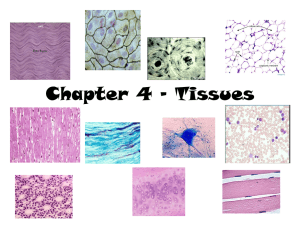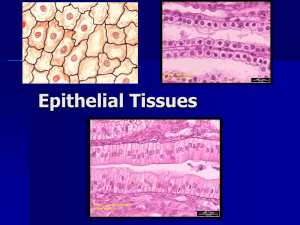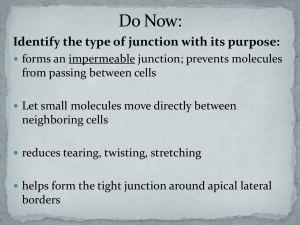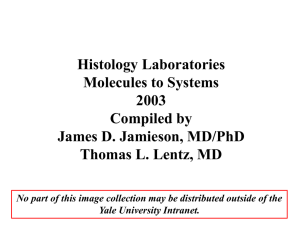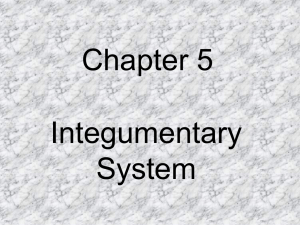Tissues: The living fabric
advertisement
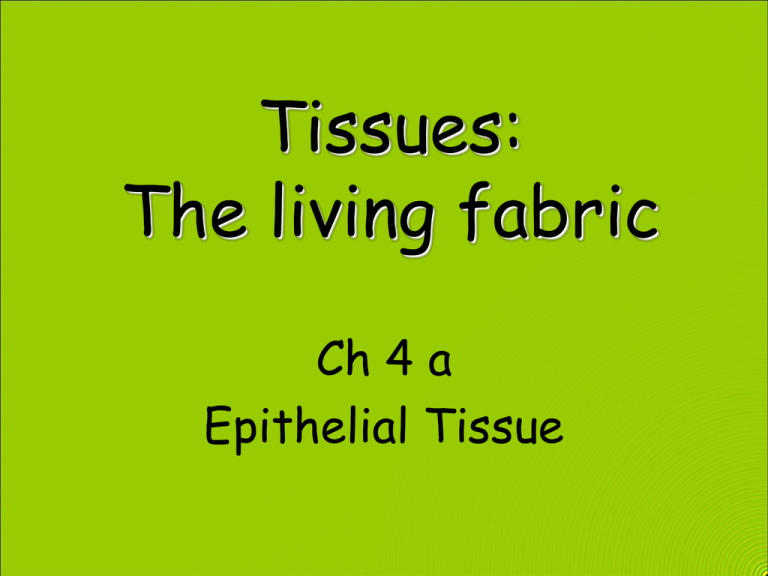
Tissues: The living fabric Ch 4 a Epithelial Tissue Tissues • Histology = Study of tissues • Tissue = Groups of cells similar in structure and function • The four types of tissues – Epithelial - covering – Connective - support – Muscle - movement – Nerve - control Epithelial Tissue • 2 types – Covering and lining epithelium – Glandular epithelium Epithelial Tissue Covering and lining epithelium Epithelial Tissue • A sheet of cells that covers a body surface or lines a body cavity • Forms boundaries between different environments Epithelial Tissue Functions • Protection • Absorption • Filtration • Excretion • Secretion (from glands) • Sensory reception Characteristics of Epithelial Tissue • Cellularity – composed almost entirely of cells – Very little extracellular material • Special contacts – form continuous sheets held together by tight junctions and desmosomes Characteristics of Epithelial Tissue • Polarity – apical and basal surfaces – Apical = free upper surface exposed to exterior of body or cavity (some are slick, some have cilia, most have microvilli) – Basal = lower surface attached Characteristics of Epithelial Tissue • Basal surface attached to basement membrane – basal laminae – thin, adhesive, non-cellular – reticular laminae – fine network of collagen fibers belonging to the connective tissue underneath, non-cellular Characteristics of Epithelial Tissue • All epithelial tissue are supported by and rest upon connective tissue Characteristics of Epithelial Tissue • Avascular but innervated – contains no blood vessels but supplied by nerve fibers – nourished by diffusion • Regenerative – rapidly replaces lost cells by cell division Classification of Epithelia Simple stratified Figure 4.1a Classification of Epithelia • Squamous • Cuboidal • Columnar Figure 4.1b Epithelia: Simple Squamous • Single layer of flattened cells with disc-shaped nuclei and sparse cytoplasm Epithelia: Simple Squamous • Functions – Diffusion and filtration – Provide a slick, friction-reducing lining in lymphatic and cardiovascular systems • Present in the kidneys, lungs, lining of heart, blood vessels, lymphatic vessels Epithelia: Simple Squamous Figure 4.2a Epithelia: Simple Cuboidal • Single layer of cubelike cells with large, spherical central nuclei • Function in secretion and absorption • Present in kidney tubules, ducts and secretory portions of small glands, and ovary surface Epithelia: Simple Cuboidal • Single layer of cubelike cells with large, spherical central nuclei • Function in secretion and absorption • Present in kidney tubules, ducts and secretory portions of small glands, and ovary surface Figure 4.2b Epithelia: Simple Columnar • Single layer of tall cells with oval nuclei; many contain cilia • Goblet cells are often found in this layer – Cells that secrete a protective lubricating mucus • Function in absorption and secretion Epithelia: Simple Columnar • Nonciliated type line digestive tract and gallbladder • Ciliated type line small bronchi, uterine tubes, and some regions of the uterus • Cilia help move substances through internal passageways Epithelia: Simple Columnar Figure 4.2c Epithelia: Pseudostratified Columnar • Single layer of cells with different heights; some do not reach the free surface • Nuclei are seen at different layers Epithelia: Pseudostratified Columnar • Function in secretion and propulsion of mucus • Present in the male spermcarrying ducts (nonciliated) and trachea (ciliated) Epithelia: Pseudostratified Columnar • Single layer of cells with different heights; some do not reach the free surface • Nuclei are seen at different layers • Function in secretion and propulsion of mucus • Present in the male sperm-carrying ducts (nonciliated) and trachea (ciliated) Figure 4.2d Epithelia: Stratified Squamous • Thick membrane composed of several layers of cells • Function in protection of underlying areas subjected to abrasion Epithelia: Stratified Squamous • Forms the external part of the skin’s epidermis (keratinized cells), and linings of the esophagus, mouth, and vagina (nonkeratinized cells) Epithelia: Stratified Squamous • Thick membrane composed of several layers of cells • Function in protection of underlying areas subjected to abrasion • Forms the external part of the skin’s epidermis (keratinized cells), and linings of the esophagus, mouth, and vagina (nonkeratinized cells) Figure 4.2e Epithelia: Stratified Cuboidal • Stratified cuboidal – Quite rare in the body – Found in some sweat and mammary glands – Typically two cell layers thick Epithelia: Stratified Columnar • Stratified columnar – Limited distribution in the body – Found in the pharynx, male urethra, and lining some glandular ducts – Also occurs at transition areas between two other types of epithelia Epithelia: Transitional • Several cell layers, basal cells are cuboidal, surface cells are dome shaped • Stretches to permit the distension of the urinary bladder • Lines the urinary bladder, ureters, and part of the urethra Epithelia: Transitional • Several cell layers, basal cells are cuboidal, surface cells are dome shaped • Stretches to permit the distension of the urinary bladder • Lines the urinary bladder, ureters, and part of the urethra Figure 4.2f Epithelial Tissue Glandular Epithelia Epithelia: Glandular • A gland is one or more cells that makes and secretes an aqueous fluid Epithelia: Glandular • Glands Classified by: – Site of product release – • Endocrine (internally secreting) or Exocrine (externally secreting) – Relative number of cells forming the gland – • Unicellular (one cell) & Multicellular (many cells) Endocrine Glands • Ductless glands that produce hormones • Secretions include amino acids, proteins, glycoproteins, and steroids Exocrine Glands • More numerous than endocrine glands • Secrete their products onto body surfaces (skin) or into body cavities Exocrine Glands • Examples include mucous, sweat, oil, and salivary glands, the liver (which secrets bile), the pancreas (which secrets enzymes) and others Unicellular Exocrine Glands • The only important unicellular exocrine gland is the goblet cell – Found in linings of intestinal and respiratory tracts – Secrets mucus Multicellular Exocrine Glands • Multicellular exocrine glands are composed of a duct and secretory unit • Classified according to: – Simple or compound duct type – Structure of their secretory units Structural Classification of Multicellular Exocrine Glands Figure 4.3a-d Structural Classification of Multicellular Exocrine Glands Figure 4.3e-g Modes of Secretion • Merocrine – products are secreted by exocytosis (e.g., pancreas, sweat, and salivary glands) • Holocrine – products are secreted by the rupture of gland cells (e.g., sebaceous glands) Modes of Secretion Merocrine Holocrine Figure 4.4 • http://www.youtube.com/watch?v=7z2v Yr5YjD8 Simple cuboidal epithelium Simple cuboidal epithelium Transitional epithelium Transitional epithelium Pseudostratified epithelium Stratified squamous epithelium What tissue is this? Simple columnar epithelial tissue Quiz – Next time! I will be checking study guides up to 1-8 • • • • • • • • • Ap = tip Areola = space Basal = foundation Blast = forming Chyme = juice Crine = separate Endo = within Epi = upon, over Glia = glue • • • • • • • • • • Holo = whole Hormon = excite Hyal = glass Lamina = thin plate Mero = part Meso = middle Retic = network Sero = watery fluid Squam = a scale Strat = layer




